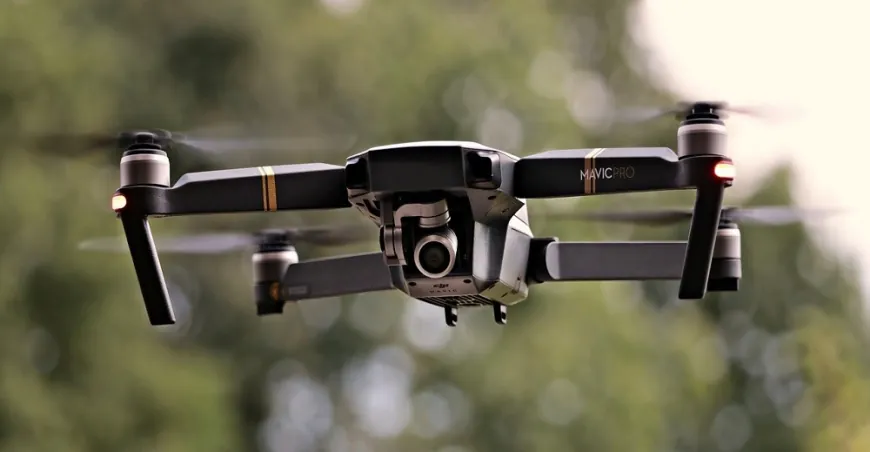AI in the Drone Market: Transforming Industries and Shaping the Future
Explore the AI in Drone Market, focusing on innovations, applications, and the transformative impact of artificial intelligence on drone technology across industries such as defense, agriculture, logistics, and more.

The integration of artificial intelligence (AI) into drone technology is revolutionizing various industries, enhancing operational efficiency, and creating new opportunities for innovation. As the global market for AI in drones is estimated to grow during the forecast period, it is essential to explore the implications of this transformation and its potential impact on the future of aerial technology.
Understanding AI in Drone Technology
AI enhances drones' capabilities by enabling them to perform complex tasks autonomously. This includes advanced navigation, data analysis, and decision-making processes that were previously reliant on human operators. The incorporation of AI allows drones to operate in challenging environments, avoid obstacles, and make real-time decisions based on sensor data.
- Autonomy: AI algorithms empower drones to navigate independently, making them suitable for various applications such as delivery services, surveillance, and agricultural monitoring.
- Data Processing: Drones equipped with AI can process vast amounts of data collected during flights, providing valuable insights that drive decision-making across sectors.
- Machine Learning: Through machine learning techniques, drones can improve their functionality over time by learning from past experiences and optimizing their operations accordingly.
Key Applications of AI-Powered Drones
AI-driven drones are being utilized across multiple industries, each benefiting from enhanced capabilities:
- Agriculture: AI drones monitor crop health, identify pests, and optimize resource use. They can analyze data to help farmers make informed decisions that lead to increased yields and reduced waste.
- Construction: In construction, drones facilitate site inspections, monitor progress, and ensure safety compliance. They can provide real-time data that helps project managers make timely decisions.
- Surveillance and Security: Drones equipped with AI can autonomously patrol areas, detect intrusions, and monitor large events. Their ability to analyze video feeds in real-time enhances security measures significantly.
- Delivery Services: Companies like UPS and Zipline are pioneering drone delivery solutions that utilize AI for route optimization and package tracking, transforming logistics and last-mile delivery.
Market Dynamics Driving Growth
Several factors are propelling the growth of the AI in drone market:
- Technological Advancements: Continuous improvements in AI algorithms and drone hardware are expanding the range of applications for drones.
- Increased Demand for Automation: Businesses are increasingly seeking automation solutions to enhance efficiency. AI-powered drones can perform tasks with minimal human intervention, making them attractive to various sectors.
- Regulatory Support: Governments worldwide are implementing regulations that facilitate drone operations, particularly in commercial applications. This supportive environment encourages investment and innovation in drone technology.
Regional Insights
North America currently leads the AI in drone market with a 36.2% share due to its strong defense sector and significant investments in R&D. The region's technological advancements have fostered a robust ecosystem for drone development and deployment.
- Asia-Pacific: This region is expected to experience rapid growth driven by expanding e-commerce markets and government support for drone technology adoption. Countries like China and Japan are at the forefront of this development.
- Europe: European countries are investing heavily in AI-powered drones for military and commercial purposes. However, strict regulations on drone usage may pose challenges to rapid market expansion.
Challenges Facing the Industry
Despite its rapid growth, the AI in drone market faces several challenges:
- Regulatory Hurdles: Navigating regulatory frameworks can be complex for companies looking to deploy drones commercially. Ensuring compliance while innovating remains a significant challenge.
- Safety Concerns: As drone usage increases, so do concerns regarding safety and privacy. Developing robust safety protocols is essential to mitigate risks associated with autonomous operations.
- Technological Limitations: While advancements continue, limitations in battery life and payload capacity still restrict some applications of drones. Ongoing research is needed to overcome these hurdles.
Future Trends in AI Drone Technology
Looking ahead, several trends are likely to shape the future of AI in the drone market:
- Swarm Technology: The development of swarm intelligence will allow multiple drones to work collaboratively on tasks such as search-and-rescue missions or agricultural monitoring, enhancing efficiency and effectiveness.
- Urban Air Mobility (UAM): The concept of UAM is gaining traction as companies explore air taxis and other forms of aerial transportation. This trend could redefine urban mobility by integrating drones into public transport systems.
- Enhanced Data Analytics: As data collection capabilities improve, so will the analytical tools used to interpret this information. Businesses will increasingly rely on AI-driven insights for strategic decision-making.
Conclusion
The integration of artificial intelligence into drone technology marks a significant leap forward in how industries operate. With its ability to enhance autonomy, improve data processing capabilities, and streamline operations across various sectors, AI-powered drones are set to reshape traditional practices significantly.
Businesses that embrace this technological evolution will not only gain a competitive edge but also contribute to transforming industries worldwide. By addressing challenges such as regulatory compliance and safety concerns while capitalizing on emerging trends like urban air mobility and swarm technology, stakeholders can navigate this dynamic landscape effectively. The future of aerial robotics is bright, driven by the power of artificial intelligence—ushering in a new era of efficiency, precision, and capability across diverse applications.












